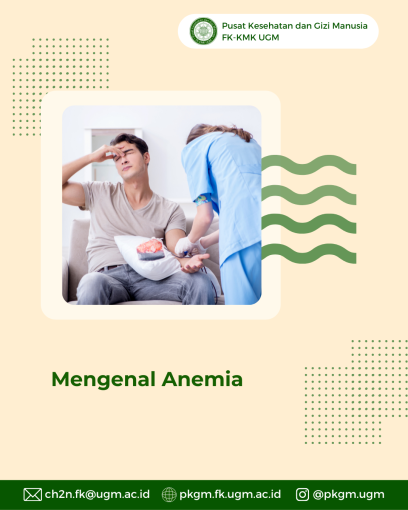
Anemia is a blood disorder condition defined by a lack of red blood cells in the body or the red blood cells can not function properly. This condition causes the body not getting enough oxygen. Anemia is a serious global health problem. Based on WHO, anemia still affects 42% of children aged <5 years and 40% of pregnant women. Symptoms that are often experienced by people with anemia are easily tired, easily drowsy, dizziness, and pale face. The most common cause of anemia is a lack of nutrients, such as vitamin B12, folate, vitamin A, and iron.
There are various types of anemia which can be classified into nutritional anemia and non-nutritive anemia. Nutritional anemia is an anemia condition that can be prevented or corrected with proper nutritional intake. While non-nutritional anemia is not caused by a lack of nutrients, but from abnormalities in body conditions. If you experience symptoms of anemia, it is important to know which type of anemia is experienced so that it can be treated appropriately.
The following are some types of non-nutritional anemia:
- Aplastic anemia
This anemia occurs due to the inability of the bone marrow to produce enough red blood cells. Aplastic anemia occurs due to genetic causes, usually a hereditary disease. To establish the diagnosis of aplastic anemia, it is necessary to perform a complete blood count and bone marrow examination.
- Sickle cell anemia
Red blood cells are normally round and flexible, but in people with sickle cell anemia the shape of the red blood cells are sickle-like and stiff, so those can easily clog small blood vessels. Sickle cells can be damaged faster than normal cells and cause oxygen circulation in the body hampered. This type of anemia is a genetic disorder. Until now there is no cure for sickle cell anemia, but blood transfusions can be done to prevent complications.
- Thalassemia anemia
Thalassemia is a genetic disorder in which the protein that forms hemoglobin can not be formed or insufficient so that red blood cells break easily. Treatment for this disease depends on the severity of the condition, usually requiring regular blood transfusions.
In addition, the following are some types of anemia caused by nutritional deficiencies:
- Iron deficiency anemia
Hemoglobin functions to transport oxygen which will later be circulated throughout the body. The body needs iron to produce hemoglobin. Lack of hemoglobin causes the body to lack oxygen supply. Initial screening for nutritional anemia can be done by assessing hemoglobin level. The healthy range for hemoglobin in men is 14-18 g/dL and in women is 12-16 g/dL In addition, if iron deficiency anemia occurs in pregnant women, it can interfere with fetal growth, increase the risk of premature birth, and even death of the mother and baby. Iron deficiency can be corrected by eating foods that are high in iron, especially those of animal such as meat, liver, milk, and eggs. In addition, increasing vitamin C intake can help the process of iron absorption.
- Megaloblastic anemia
Deficiency of vitamin B12 and folic acid can cause megaloblastic anemia. This type of anemia is a condition in which red blood cells are larger than normal or produce immature red blood cells. This condition reduces the amount of oxygen that can be carried in the blood. Vitamin B12 and folate have roles in the red blood cell regeneration process called erythropoiesis. If the body lacks these two nutrients, the formation of new red blood cells can be disrupted. Anemia can be prevented by meeting balanced nutritional needs. Vitamin B12 is found in eggs or fortified foods such as cereals, milk, cheese, and yogurt. Folic acid is found in beef liver, green vegetables, and beans.
Anemia that happens in the long term can cause damage to organs, such as the heart and lungs, since these organs have to try harder in carrying out their duties. If you experience regular symptoms such as fatigue, constant tiredness, and pale face, it is best to consult a doctor to get the right diagnosis and treatment.
References:
- Centers for Disease Control and Prevention. 2021. Thalassemia. [online]. Available at https://cdc.gov.ncbddd/thalassemia/facts.html
- Hariz A, Bhattacharya PT. 2022. Megaloblastic Anemia. StatPearls Publishing.
- National Institutes of Health. 2021. Dietary Supplement Fact Sheets: Folate. [online]. Available at https://ods.od.nih.gov/
- National Institutes of Health. 2021. Dietary Supplement Fact Sheets: B12. [online]. Available at https://ods.od.nih.gov/
- World Health Organization. 2017. Nutritional Anaemias: Tools for Evective Prevention and Control. [online]. Available at https://www.who.int/publications/
